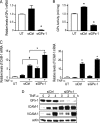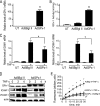Glutathione peroxidase-1 deficiency augments proinflammatory cytokine-induced redox signaling and human endothelial cell activation
- PMID: 21852236
- PMCID: PMC3195617
- DOI: 10.1074/jbc.M110.205708
Glutathione peroxidase-1 deficiency augments proinflammatory cytokine-induced redox signaling and human endothelial cell activation
Abstract
Glutathione peroxidase-1 (GPx-1) is a crucial antioxidant enzyme, the deficiency of which promotes atherogenesis. Accordingly, we examined the mechanisms by which GPx-1 deficiency enhances endothelial cell activation and inflammation. In human microvascular endothelial cells, we found that GPx-1 deficiency augments intercellular adhesion molecule-1 (ICAM-1) and vascular cell adhesion molecule-1 (VCAM-1) expression by redox-dependent mechanisms that involve NFκB. Suppression of GPx-1 enhanced TNF-α-induced ROS production and ICAM-1 expression, whereas overexpression of GPx-1 attenuated these TNF-α-mediated responses. GPx-1 deficiency prolonged TNF-α-induced IκBα degradation and activation of ERK1/2 and JNK. JNK or NFκB inhibition attenuated TNF-α induction of ICAM-1 and VCAM-1 expression in GPx-1-deficient and control cells, whereas ERK1/2 inhibition attenuated only VCAM-1 expression. To analyze further signaling pathways involved in GPx-1-mediated protection from TNF-α-induced ROS, we performed microarray analysis of human microvascular endothelial cells treated with TNF-α in the presence and absence of GPx-1. Among the genes whose expression changed significantly, dual specificity phosphatase 4 (DUSP4), encoding an antagonist of MAPK signaling, was down-regulated by GPx-1 suppression. Targeted DUSP4 knockdown enhanced TNF-α-mediated ERK1/2 pathway activation and resulted in increased adhesion molecule expression, indicating that GPx-1 deficiency may augment TNF-α-mediated events, in part, by regulating DUSP4.
Figures







Similar articles
-
Over-expression of mitogen-activated protein kinase phosphatase-2 enhances adhesion molecule expression and protects against apoptosis in human endothelial cells.Br J Pharmacol. 2010 Oct;161(4):782-98. doi: 10.1111/j.1476-5381.2010.00952.x. Br J Pharmacol. 2010. PMID: 20860659 Free PMC article.
-
Glutathione peroxidase-1 modulates lipopolysaccharide-induced adhesion molecule expression in endothelial cells by altering CD14 expression.FASEB J. 2010 Jul;24(7):2525-32. doi: 10.1096/fj.09-147421. Epub 2010 Mar 10. FASEB J. 2010. PMID: 20219985 Free PMC article.
-
Tumor necrosis factor-α-mediated suppression of dual-specificity phosphatase 4: crosstalk between NFκB and MAPK regulates endothelial cell survival.Mol Cell Biochem. 2013 Oct;382(1-2):153-62. doi: 10.1007/s11010-013-1730-7. Epub 2013 Jun 28. Mol Cell Biochem. 2013. PMID: 23812841 Free PMC article.
-
MKP-7, a negative regulator of JNK, regulates VCAM-1 expression through IRF-1.Cell Signal. 2012 Apr;24(4):866-72. doi: 10.1016/j.cellsig.2011.12.002. Epub 2011 Dec 13. Cell Signal. 2012. PMID: 22182512
-
TNFR1-induced NF-kappaB, but not ERK, p38MAPK or JNK activation, mediates TNF-induced ICAM-1 and VCAM-1 expression on endothelial cells.Cell Signal. 2007 Jun;19(6):1238-48. doi: 10.1016/j.cellsig.2006.12.013. Epub 2007 Jan 18. Cell Signal. 2007. PMID: 17292586
Cited by
-
Biomarkers, Master Regulators and Genomic Fabric Remodeling in a Case of Papillary Thyroid Carcinoma.Genes (Basel). 2020 Sep 2;11(9):1030. doi: 10.3390/genes11091030. Genes (Basel). 2020. PMID: 32887258 Free PMC article.
-
Activation of NLRX1 by NX-13 Alleviates Inflammatory Bowel Disease through Immunometabolic Mechanisms in CD4+ T Cells.J Immunol. 2019 Dec 15;203(12):3407-3415. doi: 10.4049/jimmunol.1900364. Epub 2019 Nov 6. J Immunol. 2019. PMID: 31694910 Free PMC article.
-
Oxidative stress is involved in the pathogenesis of Keshan disease (an endemic dilated cardiomyopathy) in China.Oxid Med Cell Longev. 2013;2013:474203. doi: 10.1155/2013/474203. Epub 2013 Aug 26. Oxid Med Cell Longev. 2013. PMID: 24062877 Free PMC article.
-
Mechanisms for vascular cell adhesion molecule-1 activation of ERK1/2 during leukocyte transendothelial migration.PLoS One. 2011;6(10):e26706. doi: 10.1371/journal.pone.0026706. Epub 2011 Oct 21. PLoS One. 2011. PMID: 22031842 Free PMC article.
-
Responses to reductive stress in the cardiovascular system.Free Radic Biol Med. 2017 Aug;109:114-124. doi: 10.1016/j.freeradbiomed.2016.12.006. Epub 2016 Dec 8. Free Radic Biol Med. 2017. PMID: 27940350 Free PMC article. Review.
References
-
- Raes M., Michiels C., Remacle J. (1987) Free Radic. Biol. Med. 3, 3–7 - PubMed
-
- Ursini F., Maiorino M., Brigelius-Flohé R., Aumann K. D., Roveri A., Schomburg D., Flohé L. (1995) Methods Enzymol. 252, 38–53 - PubMed
-
- Brigelius-Flohé R. (1999) Free Radic. Biol. Med. 27, 951–965 - PubMed
-
- de Haan J. B., Bladier C., Griffiths P., Kelner M., O'Shea R. D., Cheung N. S., Bronson R. T., Silvestro M. J., Wild S., Zheng S. S., Beart P. M., Hertzog P. J., Kola I. (1998) J. Biol. Chem. 273, 22528–22536 - PubMed
-
- Forgione M. A., Cap A., Liao R., Moldovan N. I., Eberhardt R. T., Lim C. C., Jones J., Goldschmidt-Clermont P. J., Loscalzo J. (2002) Circulation 106, 1154–1158 - PubMed
Publication types
MeSH terms
Substances
Grants and funding
LinkOut - more resources
Full Text Sources
Research Materials
Miscellaneous

